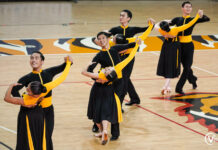SCHOOL spirits will peak once again as the country’s premiere collegiate sporting event, the University Athletic Association of the Philippines (UAAP), will kick off its 65th season next month. Throngs of students and die-hard alumni from the eight member-universities will troop to the Araneta Coliseum to witness the colorful opening festivities highlighted by an opening game of the men’s basketball tournament.
The UAAP has come a long way since its conception, overshadowing the once popular and older National Collegiate Athletic Association (NCAA), in terms of games and media mileage.
In October 1920, the University of Sto. Tomas (UST), Ateneo de Manila University (ADMU), Colegio de San Juan de Letran, and San Vicente de Paul gathered to form a sports league. Four years later, the participating schools of the “Liga Catolica” organized themselves to become the NCAA. The association easily became the most prestigious and the most popular collegiate sporting league with UST, University of the Philippines (UP), University of Manila, National University (NU), DLSU, ADMU, San Beda College and Institute of Accounts as its founding members. The newly formed league contributed to the development of national sports by producing a great number of Olympians and international sports figures.
However, the harmony of the league was disrupted in 1930 when the NCAA board of directors applied for recognition from the then Bureau of Commerce. The motion drew mixed sentiments from its members as the triumvirate of UP, UST and NU felt that this would lead to the league’s commercialization. The three universities, led by UP, initiated the exodus from the highly respected association. Dionisio D. Calvo of UST, Leong Tirol of NU and Candido Bartolome of UP — all directors of physical education — acquired the approval of the NCAA board of directors to form a sports fraternity of their own. The condition stated that NCAA-scheduled events would take precedence over the use of sports facilities.
The new league became known as the formidable “Big Three League”. Due to the overwhelming success of this experiment, the three universities finally withdrew their affiliation from the NCAA on April 6, 1932.
Despite the withdrawal, the NCAA maintained its color and fanfare and accepted new members — Mapua Institute of Technology (MIT), Jose Rizal College (now Jose Rizal University), San Sebastian College and Trinity College.
Contrary to what most people believed as a disastrous action on the part of the three universities, the Big Three grew in popularity and even surpassed the reputation of the more established NCAA mainly because some of the better athletes in the amateur ranks play for these universities. Needless to say, the Big Three flourished despite the small number of memberships in its initial years.
Birth of the UAAP
Since then, the Big Three underwent major reorganizations and expansions, paving the way for the birth of the UAAP in 1938. Representatives of the NU, UP and UST, together with Far Eastern University (FEU), already a dominant force in the collegiate sporting scene at that time, met and organized the UAAP on September 27, 1938 with FEU becoming its fourth member.
Basketball, women’s volleyball, baseball, football, swimming, and track and field were the UAAP’s maiden season sporting events. UST became the league’s first football and swimming champions while UP won the titles in baseball and track and field. FEU took home the basketball plum.
The ostensible rivalry that grew between the two leagues helped catapult the country into the international sporting scene.
In 1952, the UAAP took in University of the East (UE), Adamson University (ADU), University of Manila (UM), and the Manila Central University (MCU) on probationary status. Of the four, only ADU and UE attained permanence in the league.
As the years went by, the NCAA became plagued with controversies such as violence. A perfect example was the “basketbrawl” matches involving the then NCAA titans DLSU, ADMU, Letran and San Beda. These controversies compelled DLSU and ADMU to withdraw their membership from the league and joined the more stable and organized UAAP. ADMU was admitted in 1978 while DLSU followed in 1986.
In the early 80’s, the UAAP entered the national scene by staging national tournaments with each of the 12 regions represented. The core of the UAAP represented the dominant NCR region while Mindanao State University and San Carlos University in Cebu were some of the schools outside of Luzon. But due to budget constraints, the national tournament was short-lived and the UAAP returned to its original eight-school format.
With the dedication of the eight active members in its fold, the UAAP today has sustained the glamour and glitz of a genuine, well-organized and unpartisan athletic alliance of institutions.
UST in the UAAP
FEU dominated the UAAP in its early stagings by winning a record of 14 straight general championships from 1947-1960. UST halted FEU’s domination by taking home the general championship in 1961 and went on to score a “five-peat”. Later, UST would break FEU’s record by winning 15 straight general championships from 1982-1997. It should have been 20 straight over-all titles for the España-based athletes had UP not interrupted the amazing run by winning the UAAP general championship in 1998 with a slim margin.
Professor Felicitas Francisco, assistant director of the UST’s Institute of Physical Education and Athletes (IPEA), recalled that shocking runner-up finish to UP. “Talagang nanghinayang kami doon sa nangyari. Mga two to five points lang iyong lamang nila,” said Francisco, who was also the athletics director of the UST at that time.
After the loss, Francisco said that she even kidded to UP’s UAAP Board representative that UST only loaned them the general championship trophy that year and vowed to reclaim it the following year. Francisco’s joke turned into a prophecy as UST not only won the general championship the following year, but even kept it for the succeeding four years.
Today, UST’s campaign in the UAAP is evidently a smashing success with its record of 29 general championships proudly displayed in the UST gymnasium trophy room. Alder T. Almo

















